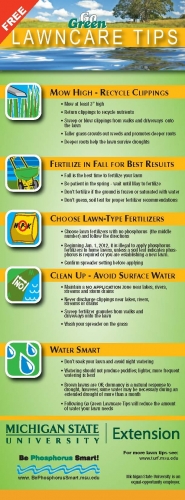Protect Michigan water resources and grow healthy lawns with "Go Green" tip sheet
Updated lawn care tip sheet reflects recent changes to the Michigan Fertilizer Law regarding lawn fertilizer and its application.

The “Go Green” tip sheet includes five main management practices designed to help protect water quality:
Mow high-recycle clippings
Maintaining at least a three inch height of cut helps to produce dense turf which can crowd out weed species, thus reducing the need for pesticides. A dense plant also promotes a deeper root system, which helps the lawn survive droughts.
Fertilize in fall for best results
If fertilizing in the spring, wait until turf begins to actively grow before fertilizing.
The Michigan Fertilizer Law prohibits the application of fertilizer on frozen or saturated soil.
The first step in creating a healthy lawn is to soil test to determine what type of fertilizer is needed, if any, and how much. Due to the Michigan Fertilizer Law, it is now illegal to apply phosphorus-containing fertilizers to lawns unless a soil test indicates phosphorus is required, a new lawn is being established, an existing lawn is in need of repair, or if certain fertilizers are applied at a specific rate described in the Law. The Michigan State University (MSU) Extension Lawn and Garden Soil Test Mailer is available through the MSU Extension Bookstore and county offices and contains everything needed to process a home soil sample (lawn, vegetable garden, tree, shrub, flower, or fruit). More information on soil testing is also available from the MSU Soil Test web site.
Choose lawn-type fertilizers
In compliance with the Michigan Fertilizer law, choose fertilizer with no phosphorus (indicated by the middle number on the bag). Be sure you know the area of the lawn to be fertilized so you know how much fertilizer to purchase and follow the label directions carefully to ensure proper application.
Clean up – avoid surface water
Maintain a “no fertilizer application” zone near water bodies and storm drains. The Michigan Fertilizer law requires that a 15-foot setback is maintained around surface water unless a spreader guard, deflector shield or drop spreader is used, in which case a 3-foot setback must be maintained. A 10-foot setback must be maintained for a continuous natural vegetative buffer. Fertilizer on impervious surfaces must be cleaned up promptly. Keep lawn clippings out of water resources by sweeping them off impervious surfaces and never discharge them directly into water or near drains.
Water smart
Choose lighter, more frequent watering instead of soaking lawn. If there is a watering restriction in your area which does not allow daytime irrigation; water after midnight if possible to reduce the risk of disease.
For more information on the Michigan Fertilizer Law, visit the Be Phosphorus Smart! website. For the latest lawn care information, visit the MSU Turf frequently throughout the gardening season.



 Print
Print Email
Email

